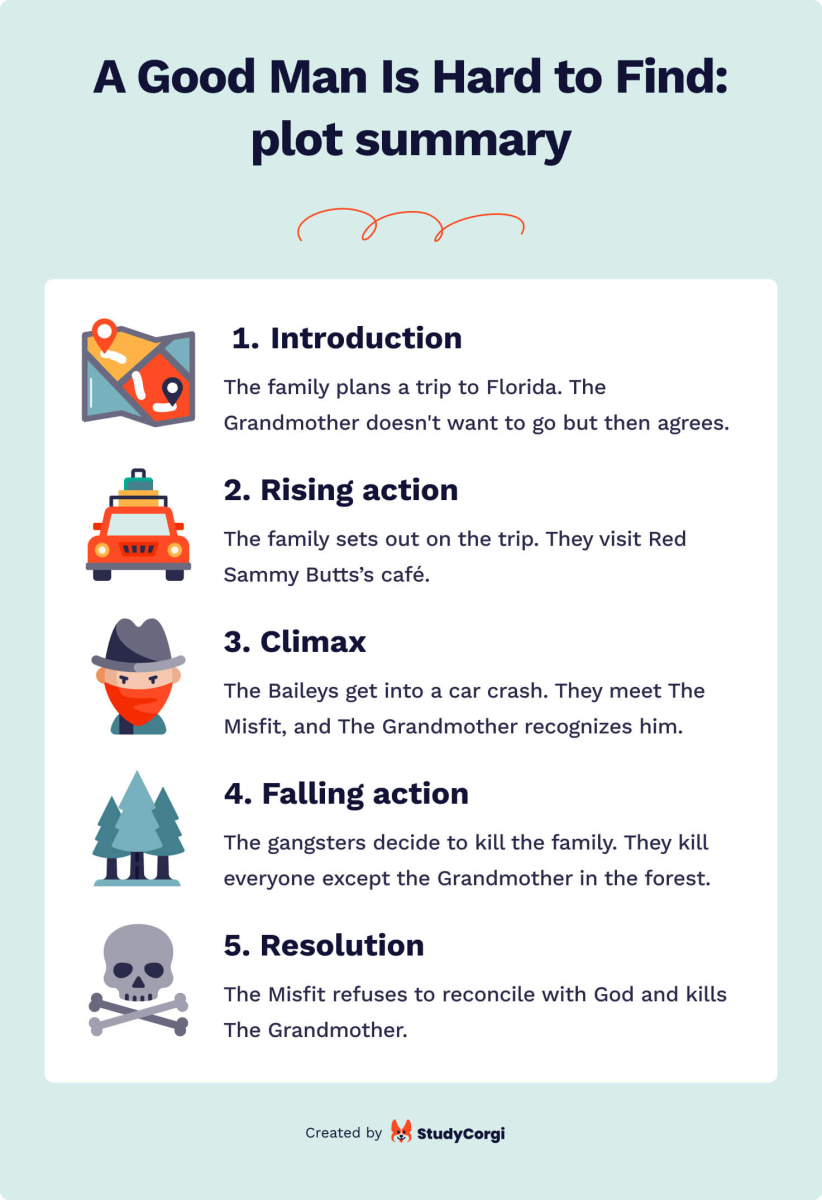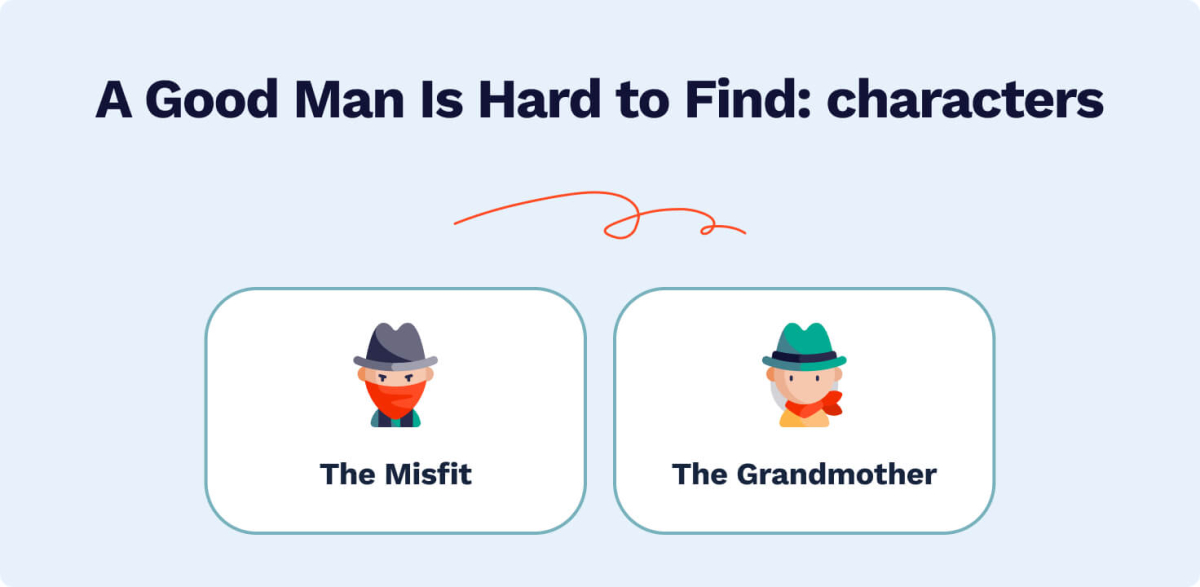A Good Man Is Hard to Find is a short story by Flannery O’Connor, one of the most famous American writers of the 20th century. In summary, A Good Man Is Hard to Find follows a family road trip to Florida that unexpectedly takes a tragic turn.
In this detailed guide, you will find:
- A Good Man Is Hard to Find plot diagram, breaking down the introduction, rising action, climax, falling action, and resolution
- Thought-provoking essay questions and prompts
- Character analysis of the Grandmother and the Misfit
- A Good Man Is Hard to Find summary
- The key themes highlighted by the author
- The most notable literary devices used in the story
Find the answers to all of your questions about A Good Man Is Hard to Find!
🔰 A Good Man Is Hard to Find Short Summary
If you want A Good Man Is Hard to Find summary condensed to one sentence, it will be as follows: a family of six travels to Florida, gets into a car crash on their way, and gets killed by an escaped convict, The Misfit.
However, if you need more careful and insightful literary analysis, things are not as simple as that. A more attentive reader would summarize the short story as follows – we’ve presented it as a diagram for your convenience.

🔝 A Good Man Is Hard to Find Essay Questions
Here are some research questions you can examine in a critical essay or research paper:
- How are love and marriage negotiated in the story?
- What are the main plot contradictions?
- What is the secular meaning of the story?
- How is individualism explored in the piece?
- What are the traces of Protestantism in the short story?
- How does A Good Man Is Hard to Find fit the concept of Catholic fiction?
- Why does the story belong to the Southern gothic style?
- How does O’Connor approach forgiveness and religiosity in the story?
- What is the role of the landscape in the story?
- How does O’Connor question southern ladyhood in the story?
- What are the traces of John Milton’s style in the short story?
- How does O’Connor approach the degradation of values in her story?
- What are the anagogical Biblical allusions in the short story?
- How does O’Connor use grotesque to talk about the idyllic agrarian South?
- What are the Civil War references in the story?
📝 A Good Man Is Hard to Find Essay Prompts
If assigned an essay about A Good Man Is Hard to Find, you may face the challenge of formulating an interesting, research-worthy topic. Indeed, there has been so much written and said about this short story that you may be clueless about a new angle. Here are a couple of essay prompts and thesis ideas our pros have prepared for your inspiration.
- Means, meaning, and mediated space in A Good Man Is Hard to Find. Flannery O’Connor talked about the failures of the Southern gothic genre to depict Southernness and addressed those problems in the short story. The means of what, in your opinion, were the characters of The Grandmother and The Misfit? What meaning did the author associate with their encounter? What unique spatial rhetoric did O’Connor apply to juxtapose the Southern ideal and the modern American capitalist image?
- Violence as a path to transformation. O’Connor used violence as a means of epiphany and transformation trajectory for its characters. How do her characters go through that path from the moment of a car crash?
- The genesis of O’Connor’s story. Where did O’Connor source inspiration for her short stories, specifically A Good Man Is Hard to Find? How does Bailey’s reading of the Atlanta Journal at the beginning of the story hint at its genesis and the materials on which it was based?
- The ambiguity of goodness in O’Connor’s A Good Man Is Hard to Find. What are the moral codes by which the story’s characters live? How do they differ? What does O’Connor associate with the “good man” concept voiced by different characters?
- The Role of The Misfit in the story. What role does The Misfit play in Grandmother’s moral transformation? Does The Misfit help her recognize her sinful life? Trace the main character’s evolution and insights during her dialogue with the criminal.
- Discussion of faith in the story. O’Connor dedicated an anthology of short stories to original sins and talked about Catholicism in her writings. How is the Catholic faith explored in A Good Man Is Hard to Find? from which angle does the author approach the concept of Catholic mercy?
- The role of foreshadowing in A Good Man Is Hard to Find. How is the foreshadowing technique used in the story? Which elements are used to predict the unfortunate outcome for The Grandmother’s family?
- Plot analysis of A Good Man Is Hard to Find. Revisit the plot and identify the roles of every character in it. How does the story’s plot develop, and what are its major turning points?
- Communication in A Good Man Is Hard to Find. Characters in the story get (or don’t get) what they want in communicating with each other. How does O’Connor approach politeness in her story, and what means and ends does politeness serve in characters’ interactions?
- The depiction of selfishness in A Good Man Is Hard to Find. Selfishness is an outstanding feature of The Grandmother. In what contexts does she reveal her selfish nature? To what consequences does it lead?
- Character analysis of The Grandmother in A Good Man Is Hard to Find. What are the main characters of O’Connor’s short story? How do they interact, and what purposes do they serve in the story’s plot?
- O’Connor’s use of symbols and metaphors in A Good Man Is Hard to Find. The story is rich in symbols and metaphors as O’Connor’s favorite literary devices. What are the most prominent of them and what is the purpose of their use?
- Dreams and reality in A Good Man Is Hard to Find. The Misfit’s character mysteriously confuses reality and dreams, unable to tell what is real and unreal in his life. What purpose does this element serve in the story? What is O’Connor’s literary goal behind the reality-dream fusion?
- Literary devices in O’Connor’s A Good Man Is Hard to Find. What literary devices does O’Connor use in the story? What function do they perform in it?
- The characters’ moral codes in A Good Man Is Hard to Find. What are the different moral codes the story’s characters follow? How do they justify those codes?
🎭 A Good Man Is Hard to Find Character Analysis
Though the story is about a family of six and contains many other characters, the core roles are assigned to two characters – The Grandmother and The Misfit.

Here is the detailed character analysis to help you understand these personas better.
The Grandmother
The Grandmother is the story’s main character.
She is highly judgmental, selfish, and self-directed, wishing that everyone follows her whims and obeys. She lives with her son’s family and tries to get things her way, though facing disrespect and neglect from most family members.
Her numerous references to her youth, courting with young gentlemen before marriage, and her sophisticated dress for the trip hint at her superficial, indolent lifestyle and non-impressive intellectual ability.
The Grandmother also acts as an aristocrat and racist, behaving as if she is superior to everyone around her. She likes to talk about the good old times – probably because she used to enjoy popularity as a young lady and led an active social life devoid of spirituality and meaning.
A meeting with The Misfit brings her face to face with a lack of grace and religion in her own life. By begging him to pray and seek salvation, The Grandmother also seems to talk to herself and realize that she also needs to gain the divine grace, at least at the end of her life. However, even at this heartbreaking climax of the story, she acts selfishly and doesn’t think about her family, begging for remorse only for herself and finally getting killed.
The Misfit
The Misfit is the story’s antagonist – the one who kills The Grandmother and her family upon their encounter on a deserted Southern road. His enigmatic character is a sharp contradiction to the ordinary, even trivial characters of The Grandmother’s family.
The Misfit is well-bred and morally reasonable, but he is a cruel criminal, killing everyone, from an infant to an old lady. He talks positively about his family but simultaneously confesses to killing his father. He is a philosopher relentlessly engaged in soul-searching and pondering over the existence of God.
Upon more careful consideration, one can see that The Grandmother and The Misfit met to encourage the religious search for grace and divine meaning in each other. A desperate man with a complex of puzzling contradictions and a superficial, selfish woman both needed a life-changing encounter, and they received that chance. Following O’Connor’s logic, they both abandoned the chance for divine grace, but the transcendent event revealed the mystery of human encounters with the divine.
Minor Characters
The minor characters include the disinterested family members of The Grandmother – her frustrated and detached son Bailey, a speechless daughter-in-law, and rude little children getting things their way with screams and misbehavior. Other characters are Red Sammy Butts – a café owner fond of complaining and remembering old times, and his distrustful wife. The story also mentions two Misfit accomplices – Hiram and Bobby Lee.
🎵 A Good Man Is Hard to Find Themes
Here are the main themes O’Connor examined in her literary piece.

Religion
The Catholic religion theme is one of the main topics in the short story. O’Connor juxtaposes real religiosity with the shallow Catholic accessories that The Grandmother uses to go for a believer. Only an encounter with death makes her realize the sinful nature of her existence and seek salvation for herself.
Death
Mentions of death have been woven into the story’s fabric since its beginning. The Grandmother talks about The Misfit as a murderer and insists on taking Pitty Sing with them, afraid of his death alone at home. The Grandmother dresses up to show everyone that she is a lady, even if her corpse is to be found after a car crash. Thus, death is the family’s companion throughout the story, coming in its ugly, tangible form upon encountering The Misfit. Death becomes the moment of The Grandmother’s revelation and enlightenment, as only the fear of death makes her sincere to herself.
Grace
In religious terms, divine grace is the moment of epiphany during which the believer comes face to face with their genuine nature and can achieve peace of mind and spiritual salvation. The Grandmother’s and The Misfit’s spiritual blindness are examined in the story as barriers to salvation and their inability to unite with God.
🗺️ A Good Man Is Hard to Find Setting
A Good Man Is Hard to Find was written in the best tradition of Southern gothic literature, which is evident from the typical description of the story’s setting. It was popular among Southern gothic writers to use the scenery of the American South as facilitating devices in their plots. Here, the reader also comes across such images like:
- Lonely plantations
- Aging and lonely Southerners (the figure of Red Sammy Butts and his small road café)
- Dusty downtown
- References to slavery past (a black child The Grandmother referred to as a “little nigger”)
Besides, the story complies with other conventions of the genre by featuring shallow, morally degrading characters that are “not quite right” in universal human terms. The main characters – The Grandmother and The Misfit – both have troubles with morality, though each in their own way.
🔍 A Good Man Is Hard to Find Literary Analysis
O’Connor also used many literary and stylistic means to enrich her short story with multiple levels of meaning. Here is the detailed literary analysis to guide your interpretation work.
What Is the Message in A Good Man Is Hard to Find?
The author’s central message is the power of human compassion and God’s grace in the transformation of shallow, non-religious creatures. The Misfit and The Grandmother receive a chance to understand genuine goodness during their life-changing encounter.
What Is the Moral of A Good Man Is Hard to Find?
O’Connor was an ardent Catholic, so her short stories mostly focused on religious vices and virtues. Her moral lesson in this story is the evil nature of selfishness and the person’s inability to attain divine grace from the position of selfishness and self-centeredness.
Symbolism in A Good Man Is Hard to Find
The story is filled with many symbols, such as The Grandmother’s hat (the woman’s hypocrisy and self-centeredness), The Misfit’s automobile (a “black, battered hearse-like” vehicle signaling that only death awaits those who meet it).
There are also many symbolic references to animals in the story. The daughter-in-law’s headkerchief is compared to a rabbit’s ears, The Misfit presents himself as a “different breed of dog” from his siblings, and Bailey’s voice becomes “a snarl” when he blames his mother. Thus, O’Connor likened all characters to animals, unable to analyze their actions and living simple lives directed at survival.
Imagery in a Good Man Is Hard to Find
Besides the numerous symbols, the short story contains many allusions to people and cultural artifacts. For instance, the young boy’s name is John Wesley – an allusion to one of the first Anglican Church ministers in the USA. The cat’s name is an allusion to a comic opera, Mikado, featuring a character concerned about fitting the crime to the punishment (just like The Misfit). Gone with the Wind and The Tennessee Waltz both serve as metaphors for The Grandmother’s longing for her hilarious past, which becomes the source of her family’s problems.
Irony in a Good Man Is Hard to Find
Irony is used many times in the story to show how skillfully The Grandmother deceives the whole family and leads them to demise while being Bailey’s mom – a woman promising never to put her family at risk. In fact, all family troubles occur because of The Grandmother’s selfish whims and an absence of care for the rest of her family and their interests.
Another illustrative example of irony is The Grandmother’s repeated appeals to The Misfit as “a good man.” She tries to convince him not to kill her because she’s a lady, which is highly ironic, as she led the whole family to this tragedy and has never been a good person.
Foreshadowing in a Good Man Is Hard to Find
O’Connor used many elements of foreshadowing in the story.
The Misfit is mentioned in the first lines, dooming the family to an encounter with him. The family sees a graveyard and tombstones on their way – literal death artifacts. The Misfit’s automobile looks like a hearse, promising death to everyone.
Besides, the woods in which The Grandmother’s encounter with The Misfit foreshadowed the family’s death. O’Connor described them as “a dark open mouth” that would soon absorb everyone’s lives.
Tone in a Good Man Is Hard to Find
O’Connor used different tones to achieve the intended effect of the story’s reading. In some places, the narrative sounds humoristic, while in others, it is full of detachment and focuses only on recording events and family members’ actions.
The story is also full of irony, which gets bitter when the family encounters The Misfit. In most fragments, the author used a serious tone – especially after the family met with the criminals and the elevating tension of family members’ killings.
With these tips and suggestions, you’re sure to complete a literary or critical analysis essay about A Good Man Is Hard to Find without any trouble. Look through our prompts, follow the writing advice, and your professor will be impressed by the depth and insight of your literary analysis of O’Connor’s story.
